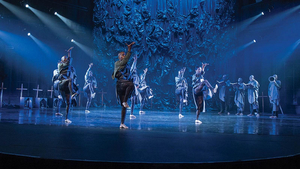Review: CION: REQUIEM OF RAVEL'S BOLERO by Vuyani Dance Theatre At Kennedy Center

On some weekends, the Kennedy Center for the Performing Arts looks like the country's epicenter of dance.
At the same time Matthew Bourne's "Swan Lake" is drawing throngs at the Opera House, the debut of Gregory Maqoma's Vuyani Dance Theatre is making its debut before its own large crowds in the Eisenhower Theatre with its own innovative interpretation of a classic piece.
Maqoma, a South African dance star and choreographer, is presenting his dark requiem on death and grief, put to the familiar, driving music of Maurice Ravel's "Boléro."
That music is mixed and reinterpreted by the soaring, a cappella sounds of South Africa singers even as it tells the tale of South African author Zakes Mda's "Cion."
The one hour "Cion: Requiem of Ravel's Bolero" debuted in D.C. Friday in a void, with a human cry and wailing of grief piercing complete darkness, which brightened only slightly after a spell to show its mournful figure walking through a graveyard.
Behind the figure a group gestures and implores, as if to reach out in helping soothe the type of mourning that will eventually touch us all. The lead character is Toloki, a South African professional mourner who was in Mda's previous work "Ways of Dying," In "Cion," he moves through an Appalachian graveyard in southeastern Ohio where he hears the stories of runaway slaves.
A rat-a-tat of a snare drum introduces the building march of Ravel's familiar piece - a rare instrument in a piece whose live music would otherwise come from vocalization (including one from behind a horn)
Western audiences may recognize Isicathamiya, the a cappella singing and its attendant broad movementsm, from popular singing groups like Ladysmith Black Mambazo. Maqoma's vision reflects that splendid mix but compounds the soft-footed movement with other approaches, including at one point the stomp of a dancer in tap shoes.
The nine piece troupe with exuberant extensions are all in bare feet, as if to connect further to the Earth to which all will return. One standout dancer - Otto Andile Nhlapo, the only one awarded with shoes - quakes and moves in quick jabbing moves often reflective of hip-hop street dances (and as such, received the kind of instant audience reactions such moves usually bring).
The four piece singers, who echo so much in African-American music from Zulu origins to doo wop harmonizing are under the direction of composer Nhlanhla Mahlango.
A further adaptation of hip hop allows is Simphiwe Bonongo's inventive beat-boxing, with sound effects and repeated vocal patterns that replicate the rat-a-tat rhythms of the familiar "Boléro."
As the movements broaden, lighting director Mannie Manim brightens the milieu as well, and we can see what had been a murky backdrop is seen to be a topography of the dirt and mountains, from set designer Oliver Hauser. Does this reflect a brightening or a lessening of mournfulness? At least, it hints a way forward.
If Maqoma did not dance to the 2017 piece with his Vuyani Dance Theatre, which he formed in 2007, at least he was on hand to conduct a conduct a talk-back on the first of the two-night engagement.
Running time: About 70 minutes, no intermission.
Photo credit: Siphosihle Mkhwanazi
"Icon: Requiem of Ravel's 'Bolero' " by Gregory Maqoma's Vuyani Dance Theatre performed Jan. 24 and 24 at the Kennedy Center for the Performing Arts. For more information go online.
Add Your Comment
Videos
